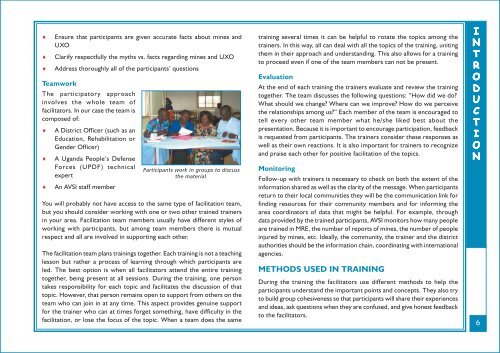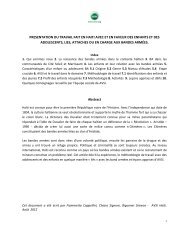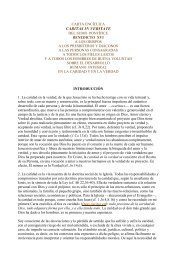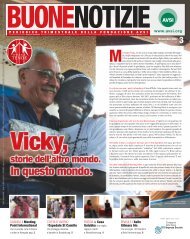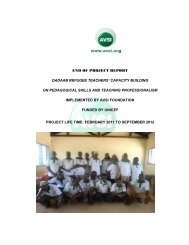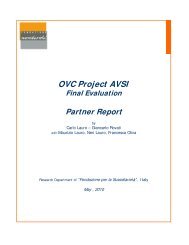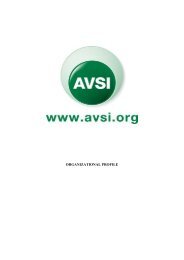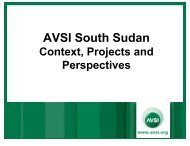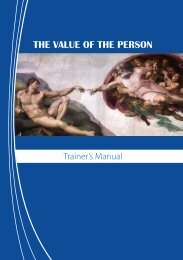Mine risk education training module - Avsi
Mine risk education training module - Avsi
Mine risk education training module - Avsi
Create successful ePaper yourself
Turn your PDF publications into a flip-book with our unique Google optimized e-Paper software.
♦<br />
♦<br />
♦<br />
Ensure that participants are given accurate facts about mines and<br />
UXO<br />
Clarify respectfully the myths vs. facts regarding mines and UXO<br />
Address thoroughly all of the participants’ questions<br />
Teamwork<br />
The participatory approach<br />
involves the whole team of<br />
facilitators. In our case the team is<br />
composed of:<br />
♦<br />
♦<br />
♦<br />
A District Officer (such as an<br />
Education, Rehabilitation or<br />
Gender Officer)<br />
A Uganda People’s Defense<br />
Forces (UPDF) technical<br />
expert<br />
An AVSI staff member<br />
Participants work in groups to discuss<br />
the material.<br />
You will probably not have access to the same type of facilitation team,<br />
but you should consider working with one or two other trained trainers<br />
in your area. Facilitation team members usually have different styles of<br />
working with participants, but among team members there is mutual<br />
respect and all are involved in supporting each other.<br />
The facilitation team plans <strong>training</strong>s together. Each <strong>training</strong> is not a teaching<br />
lesson but rather a process of learning through which participants are<br />
led. The best option is when all facilitators attend the entire <strong>training</strong><br />
together, being present at all sessions. During the <strong>training</strong>, one person<br />
takes responsibility for each topic and facilitates the discussion of that<br />
topic. However, that person remains open to support from others on the<br />
team who can join in at any time. This aspect provides genuine support<br />
for the trainer who can at times forget something, have difficulty in the<br />
facilitation, or lose the focus of the topic. When a team does the same<br />
<strong>training</strong> several times it can be helpful to rotate the topics among the<br />
trainers. In this way, all can deal with all the topics of the <strong>training</strong>, uniting<br />
them in their approach and understanding. This also allows for a <strong>training</strong><br />
to proceed even if one of the team members can not be present.<br />
Evaluation<br />
At the end of each <strong>training</strong> the trainers evaluate and review the <strong>training</strong><br />
together. The team discusses the following questions: “How did we do<br />
What should we change Where can we improve How do we perceive<br />
the relationships among us” Each member of the team is encouraged to<br />
tell every other team member what he/she liked best about the<br />
presentation. Because it is important to encourage participation, feedback<br />
is requested from participants. The trainers consider these responses as<br />
well as their own reactions. It is also important for trainers to recognize<br />
and praise each other for positive facilitation of the topics.<br />
Monitoring<br />
Follow-up with trainers is necessary to check on both the extent of the<br />
information shared as well as the clarity of the message. When participants<br />
return to their local communities they will be the communication link for<br />
finding resources for their community members and for informing the<br />
area coordinators of data that might be helpful. For example, through<br />
data provided by the trained participants, AVSI monitors how many people<br />
are trained in MRE, the number of reports of mines, the number of people<br />
injured by mines, etc. Ideally, the community, the trainer and the district<br />
authorities should be the information chain, coordinating with international<br />
agencies.<br />
METHODS USED IN TRAINING<br />
During the <strong>training</strong> the facilitators use different methods to help the<br />
participants understand the important points and concepts. They also try<br />
to build group cohesiveness so that participants will share their experiences<br />
and ideas, ask questions when they are confused, and give honest feedback<br />
to the facilitators.<br />
I<br />
N<br />
T<br />
R<br />
O<br />
D<br />
U<br />
C<br />
T<br />
I<br />
O<br />
N<br />
6


